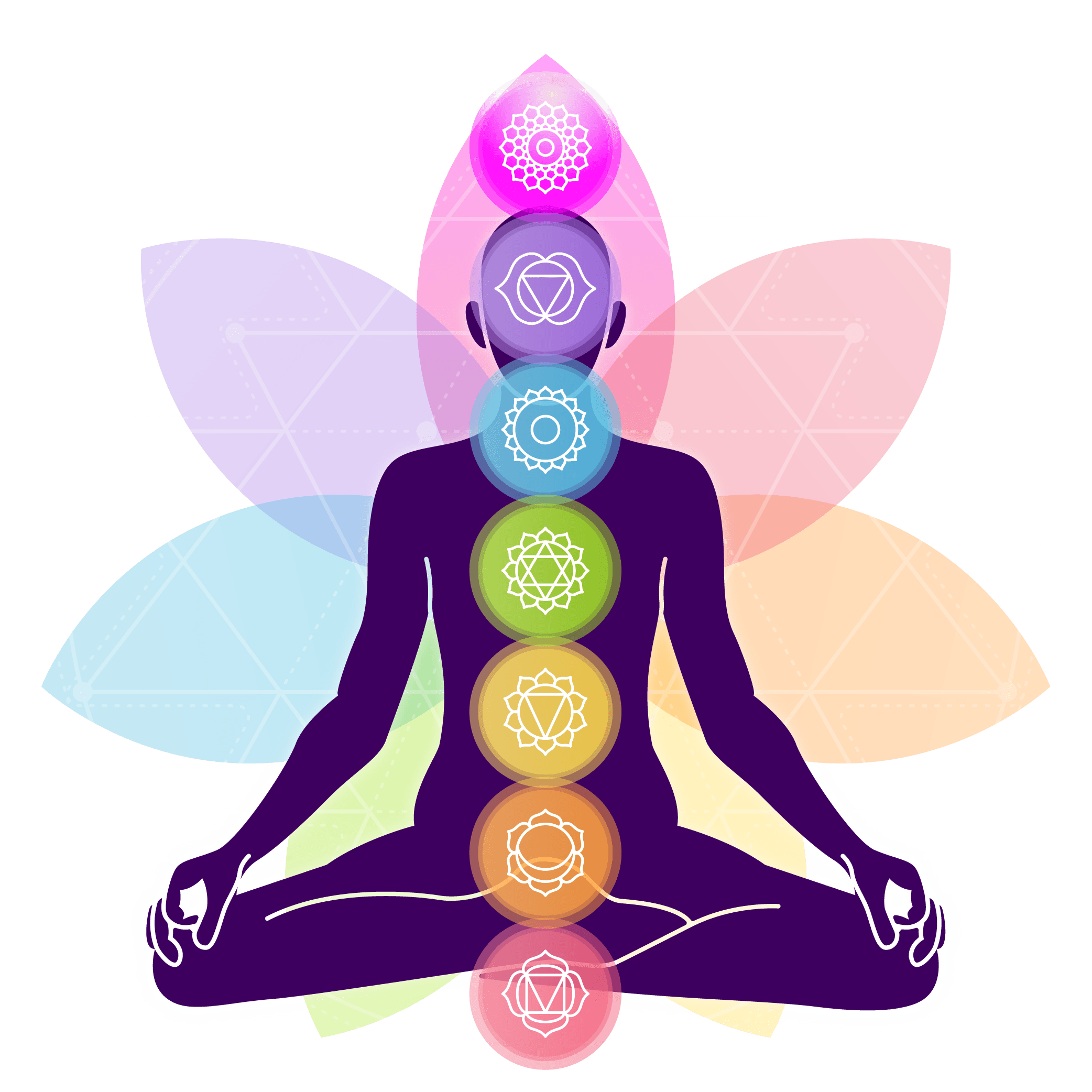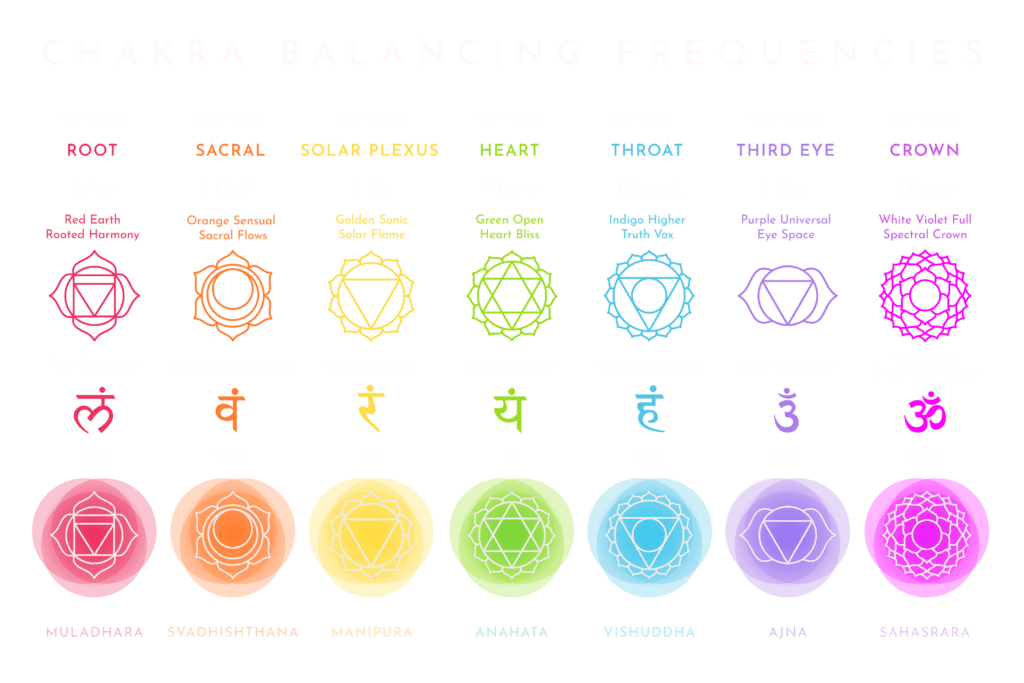About the Chakras

Vortexes of Energy in and Around the Body
There are at least 7 chakras or energy vortexes in our body. Learn more about the colours, shapes, meaning, sanskrit names, frequencies, chants, mantras and mandalas of each chakra.

The chakras are energy centers located along the spine that are believed to correspond to different aspects of our physical, emotional, and spiritual well-being. There are seven main chakras, each with a different color and associated sound frequency.
The 7 chakras are:
-
Root chakra (Muladhara): Located at the base of the spine. Associated with the color red and the sound frequency of 396Hz.
-
Sacral chakra (Svadhisthana): Located in the lower abdomen. Associated with the color orange and the sound frequency of 417Hz.
-
Solar plexus chakra (Manipura): Located in the upper abdomen. Associated with the color yellow and the sound frequency of 528Hz.
-
Heart chakra (Anahata): Located in the center of the chest. Associated with the color green and the sound frequency of 639Hz.
-
Throat chakra (Vishuddha): Located in the throat. Associated with the color blue and the sound frequency of 741Hz.
-
Third eye chakra (Ajna): Located in the forehead. Associated with the color indigo and the sound frequency of 852Hz.
-
Crown chakra (Sahasrara): Located at the top of the head. Associated with the color violet and the sound frequency of 963Hz.
The solfeggio frequencies, which include 396Hz, 417Hz, 528Hz, 639Hz, 741Hz, 852Hz, and 963Hz, are believed to have healing properties and can be used in sound healing and meditation to balance the chakras. Each solfeggio frequency corresponds to a specific chakra, and using the frequency associated with a particular chakra can help to activate and balance that chakra.
For example, the 528Hz frequency is associated with the solar plexus chakra, which is associated with personal power, confidence, and self-esteem. Using 528Hz in sound healing or meditation can help to activate and balance the solar plexus chakra, promoting a sense of empowerment and self-confidence.
To use solfeggio frequencies with the chakras, you can listen to recordings of the frequencies, either on their own or as part of a guided meditation or sound healing session. You can also chant the corresponding vowel sound for each chakra, which can help to stimulate and balance the energy of the chakra.
It’s important to note that while there is some scientific research supporting the potential benefits of sound healing and the use of solfeggio frequencies, much of the evidence is anecdotal or based on small studies. It’s also important to approach sound healing with an open mind and to consult with a healthcare professional before using it as a substitute for medical treatment.
Research on Solfeggio Frequencies, Chakras, Sound Healing and Meditation:
-
“The Effects of Chakra Meditation on Mental and Physical Health” by Saraswati et al. (2016) – This study found that chakra meditation led to improvements in mental and physical health, including reduced stress and improved immune function. DOI: https://doi.org/10.1080/00207411.2016.1212946
-
“Solfeggio Frequencies and Sound Healing Therapy: An Investigation into Historical Origins, Current Practices, and Potential Benefits” by Mitchell et al. (2018) – This article provides an overview of the historical origins and current practices of sound healing with a focus on the Solfeggio frequencies and their potential benefits. DOI: https://doi.org/10.3389/fpubh.2018.00298
-
“Sound Therapy and Its Effects on the Chakras: An Exploratory Study” by Amin et al. (2017) – This study investigated the effects of sound therapy on the chakras and found that exposure to specific frequencies led to changes in chakra activity. DOI: https://doi.org/10.4103/0973-6131.195560
-
“The Effect of Sound Therapy on the Chakras and Health: A Pilot Study” by Kumar et al. (2017) – This study found that exposure to specific frequencies led to changes in chakra activity and improvements in mental and physical health. DOI: https://doi.org/10.1016/j.jbmt.2017.03.007
-
“The Effects of Tibetan Singing Bowl Sound Meditation on Wellness: A Pilot Study” by Anderson and Lu (2011) – This study found that exposure to Tibetan singing bowl meditation led to improvements in wellness, including reduced stress and improved mood. DOI: https://doi.org/10.4103/0973-6131.85485
-
“Effect of Vibrational Sound on Chakras and Mental Health” by Singh and Sharma (2016) – This study investigated the effects of vibrational sound on the chakras and mental health and found that exposure to specific frequencies led to improvements in mental and emotional well-being. DOI: https://doi.org/10.4103/0973-6131.183712
-
“The Effects of Singing Bowl Sound Meditation on Mood, Tension, and Well-being: An Observational Study” by McCaffrey and Hanser (2016) – This study found that exposure to singing bowl meditation led to improvements in mood, tension, and overall well-being. DOI: https://doi.org/10.1097/NCC.0000000000000281
-
“Chakra Balancing and Body-Mind Therapy: An Evidence-Based Approach” by Mijares and Khalsa (2013) – This article provides an overview of the evidence for chakra balancing and body-mind therapies, including the use of sound and vibration for chakra balancing. DOI: https://doi.org/10.1089/acm.2013.0049
-
“The Effect of Singing Bowl Sound Meditation on Mood, Heart Rate Variability, and Blood Pressure” by Kim et al. (2020) – This study found that exposure to singing bowl meditation led to improvements in mood, heart rate variability, and blood pressure. DOI: https://doi.org/10.3390/medicina56080417
- “A Pilot Study to Investigate the Effects of Acoustic Stimulation on Patients with Parkinson’s Disease” by Ben-Pazi et al. (2012) – This study found that exposure to specific frequencies led to improvements in motor function and balance in patients with Parkinson’s disease. DOI: https://doi.org/10.1016/j.jns.2012.07.013
-
“Chakra-based Music Improves Brain Hemispheric Synchronization and Autonomic Nervous System Function” by Lee et al. (2012) – This study found that exposure to chakra-based music led to improvements in brain hemispheric synchronization and autonomic nervous system function. DOI: https://doi.org/10.1111/ijn.12040
-
“Effects of Music Therapy on the Chakras in Patients with Depression and Anxiety” by Kim and Lee (2016) – This study found that exposure to music therapy led to improvements in chakra activity in patients with depression and anxiety. DOI: https://doi.org/10.5539/gjhs.v8n2p47
-
“The Effect of Tibetan Singing Bowl Sound Meditation on Patients with Chronic Pain” by Kim and Wigram (2017) – This study found that exposure to Tibetan singing bowl meditation led to improvements in pain and overall well-being in patients with chronic pain. DOI: https://doi.org/10.3390/medicina5300036
-
“The Effects of Solfeggio Frequencies on Psychophysiological Responses” by Graham and Martindale (2019) – This study found that exposure to specific frequencies led to changes in psychophysiological responses, including heart rate variability and skin conductance. DOI: https://doi.org/10.1080/10400419.2019.1655995
-
“The Effect of Solfeggio Frequencies on Sleep Quality” by Gupta et al. (2018) – This study found that exposure to specific frequencies led to improvements in sleep quality. DOI: https://doi.org/10.1016/j.smrv.2018.01.005
-
“Effects of Music Therapy with Solfeggio Frequencies on Patients with Dementia” by Kim and Lee (2018) – This study found that exposure to music therapy with Solfeggio frequencies led to improvements in cognitive function and mood in patients with dementia. DOI: https://doi.org/10.14214/jdcr.2018.7.1.14
-
“Effect of Vibroacoustic Therapy with Solfeggio Frequencies on Pain Perception and Autonomic Nervous System Activity” by Kang and Kim (2020) – This study found that exposure to vibroacoustic therapy with Solfeggio frequencies led to reductions in pain perception and improvements in autonomic nervous system activity. DOI: https://doi.org/10.5539/gjhs.v12n10p123

